Some people are driven by the motto, “Bigger Is Better,” and it extends to their fish, too. Unfortunately, it’s definitely not the case when it comes to tetras.
Although these fish have been a popular staple in the aquarium trade for more than a century, they don’t grow as large as some people may think. According to Fishbase, the average size of an adult tetra is 2.6 inches (6.6 cm).
Generally speaking, African tetras tend to be larger than South American species, so they are well suited to large community aquariums with bigger fish. But believe it or not, the largest recognized tetra is from South America.
If you have your heart set on a large tetra breed, here are some of the most popular ones available.
What is the Largest Known Tetra in the World?
The largest tetra in the world is Brycon orbignyanus, one of the large tetras of open water [1]. It is native to the La Plata River basin in South America and can reach up to 31.1 inches (79.5 cm) in length.
The genus Brycon is a group of large tetras that are found in freshwater habitats in Central and South America. This genus currently has 46 described species, of which the notable members include the #2 largest tetra –the Machaca (Brycon guatemalensis)– as well as the #3 largest tetra – Brycon hilarii.
| Species | Total Length (Inches) | Total Length (cm) |
|---|---|---|
| Brycon orbignyanus | 31.1 | 79.5 |
| Brycon guatemalensis | 23.2 | 59 |
| Brycon hilarii | 22.0 | 56 |
Though large Brycon species are not well-known among aquarists, they’re important in commercial and sport fishing because of their active and aggressive behaviors [2].
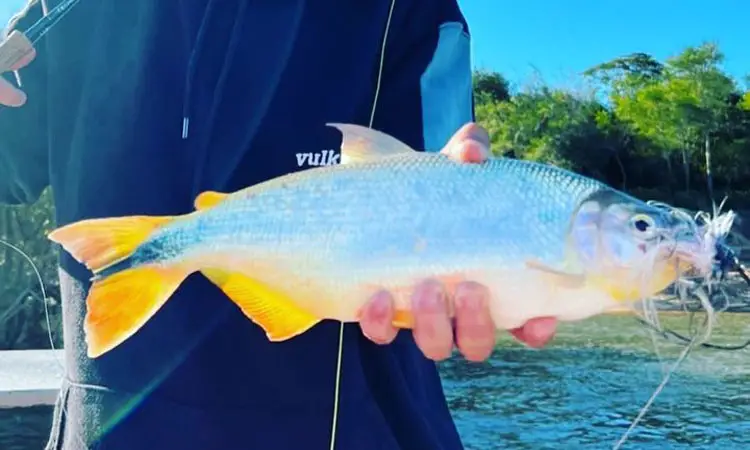
10 Most Common Large Tetras for Your Aquarium
Thankfully, most tetras don’t have such large sizes, so to help you get an idea of large tetras suitable for your aquarium, we have compiled a list of our favorite species that are readily available in the aquarium hobby.
Longfin tetra (Brycinus longipinnis) – 6.5″ (16.4cm)
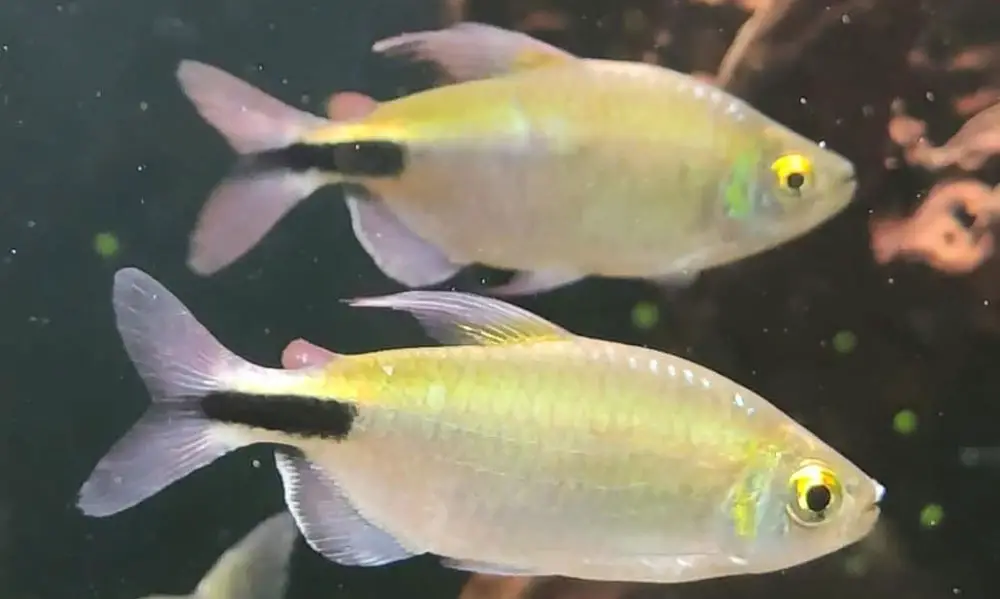
This underrated fish is commonly kept in a larger community tank, ideally, a dedicated West African setup since the geographic origins of this fish are the Gambia to the Democratic Republic of Congo.
Like most tetras, they are very active and do best when kept in small groups of at least 6 individuals or more. Therefore, it’s best to keep them in large tanks as it needs ample swimming space.
Our favorite stocking choice for these fish are:
- Congo tetras (Phenacogrammus interruptus)
- Niger tetra (Arnoldichthys spilopterus)
- Kribs (Pelvicachromis pulcher)
- Synodontis spp. (Cuckoo Catfish | Dwarf Petricola | Lace catfish)
Still, they can get along well with other African fish of similar sizes.
| Scientific Name: | Brycinus longipinnis |
| Common Name: | Longfin tetra |
| Care Level: | Beginner |
| Origin: | West African |
| Social: | Peaceful shoaling species, suitable for community tanks |
| Temperature: | 72 – 79°F (22 – 26°C) |
| PH: | 6.0 – 7.8 |
| Water hardness: | 3 – 20 dKH |
| Diet: | Omnivorous |
| Minimum Tank Size: | 40 gallons Breeder (48″ x 12″ x 16″) |
Mexican tetra (Astyanax mexicanus) – 5.9″ (15cm)
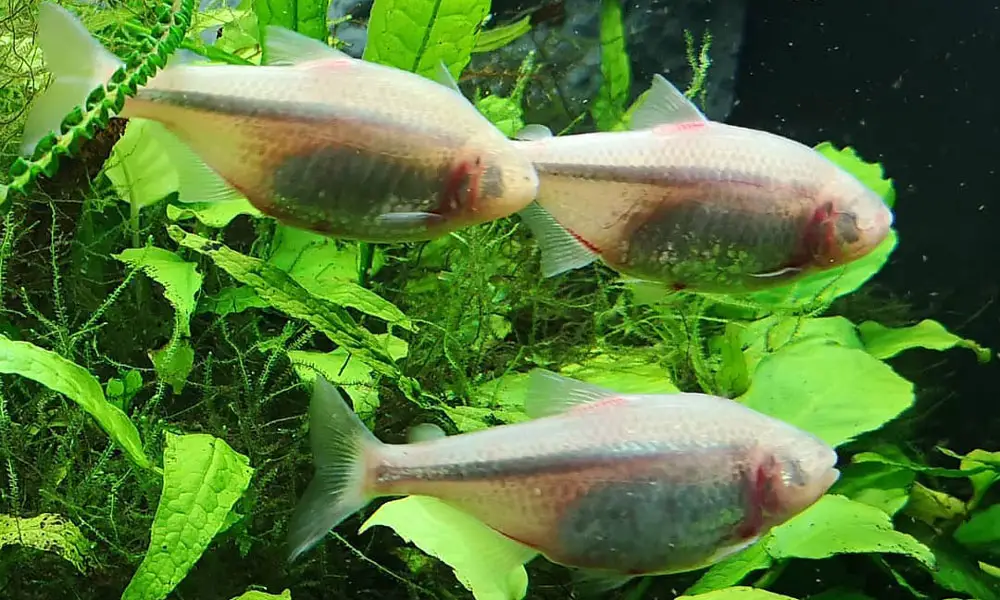
Here is another larger tetra you might consider for large aquariums with bigger fish. Also known as blind cave tetras or cave tetra, this oddball fish is known for its eye loss and colorless appearance.
Despite their eyeless looks, blind cave tetras are very easy-going. They are also peaceful enough to live in a community tank but still prefer to be in groups of half-dozen of their own kind.
To recreate their natural underground cave habitat, building a cave-style aquarium covered with black aquarium background would be best. But it’s not usually necessary if you have a standard aquarium setup. Read their full care guide for more details.
| Scientific Name: | Astyanax mexicanus (in dispute) |
| Common Name: | Blind Cave Fish, Cave Tetra |
| Care Level: | Beginner |
| Origin: | North America and Mexico |
| Lifespan: | up to 15 years |
| Tank Level: | All levels |
| Social: | Peaceful shoaling species, suitable for community tanks |
| Temperature: | 68 – 77°F (20 – 25°C) |
| PH: | 6 – 7.8 |
| Water hardness: | 4 – 30 dKH |
| Diet: | Omnivorous |
| Minimum Tank Size: | 20 gallons |
Glass Tetra (Moenkhausia oligolepis) – 4.0″ (10cm)
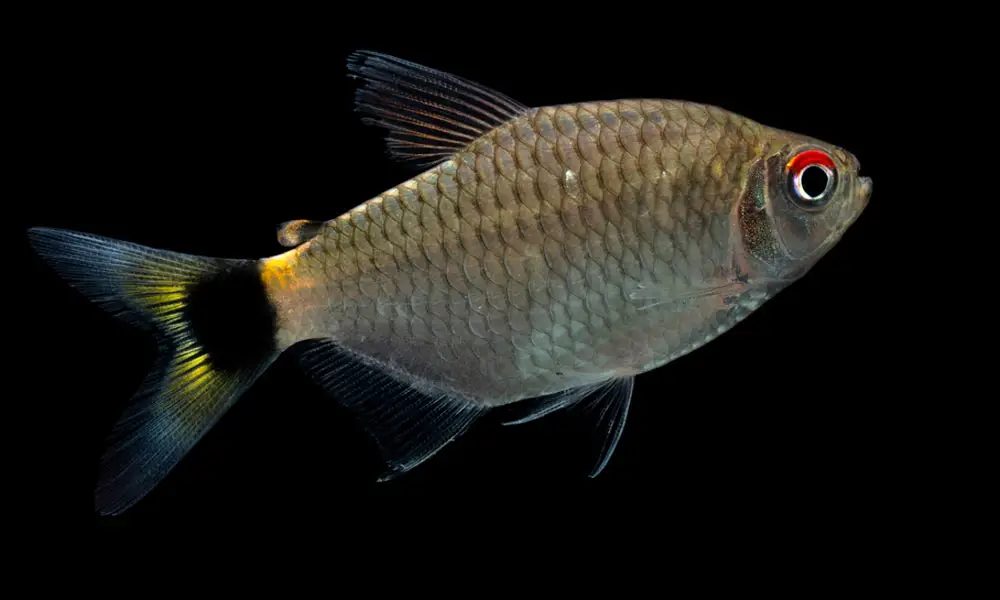
Perhaps the most noticeable feature of this large tetra is its bold red eyes, which really pop against their silver, or dull yellow bodies.
They originate from slow-moving rivers and creeks of the Amazon River basin, where they are also prized for their tight schooling behavior.
Very peaceful but a little more boisterous, making them unsuitable for keeping with fish with similar personalities or aggressive fish.
| Scientific Name: | Moenkhausia oligolepis |
| Common Name: | Glass Tetra |
| Care Level: | Beginner |
| Origin: | South America |
| Social: | Peaceful shoaling species |
| Temperature: | 75- 82°F (24 – 28°C) |
| PH: | 5.5 – 7.2 |
| Water hardness: | 1 – 12 dKH |
| Diet: | Omnivorous |
| Minimum Tank Size: | 20 gallons |
Niger Tetra (Arnoldichthys spilopterus) – 3.8″ (9.6cm)
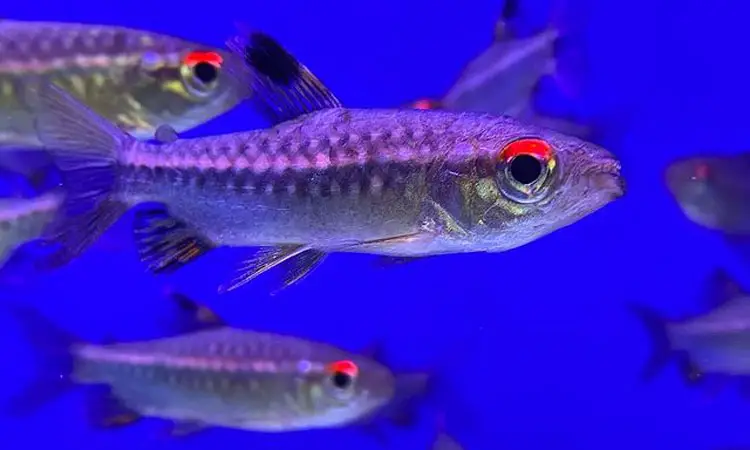
The Niger Tetra, also called the African Red Eyed Tetra or Big Scaled Tetra, is a popular fish in many community aquariums. Measuring 3–4 inches (7–10 cm), these colorful fish are native to Nigeria, as their common name would suggest.
This attractive species is most distinguished by its huge scales and reddish eyes. Males are more colorful than females and have dark stripes on the anal fin.
This active shoaling species is another great pick for African biotope aquariums. Also, they are peaceful and sometimes can be shy, so large groups of 10 or more are preferred.
| Scientific Name: | Arnoldichthys spilopterus |
| Common Name: | Niger Tetra, African Red Eyed Tetra, Big Scaled Tetra |
| Care Level: | Beginner |
| Origin: | Nigeria |
| Social: | Peaceful shoaling species |
| Temperature: | 73- 82°F (23- 28°C) |
| PH: | 6.0 – 8.0 |
| Water hardness: | 5 – 19 dKH |
| Diet: | Omnivorous |
| Minimum Tank Size: | 40 gallons Breeder (48″ x 12″ x 16″) |
Silver Tetra (Ctenobrycon spilurus) – 3.1″ (8cm)
Often referred to as the silver dollar tetra, the silver tetra is generally a shiny silver over the round flattened body but with a gold tint on top.
This fish comes from shallow, slow-moving streams of the Orinoco River basin with plenty of aquatic plants. With its shimmering silver body, it’s best visualized in a fish tank full of green aquatic plants. Don’t worry; this species will not eat most live plants like silver dollar cichlid (Metynnis argenteus).
This shiny tetra shares the same care needs with most fish in this list. Keep them in a bigger group of 6–10 fish with other gentle, non-aggressive tankmates.
| Scientific Name: | Ctenobrycon spilurus |
| Common Name: | Silver dollar tetra, silver tetra |
| Care Level: | Beginner |
| Origin: | South America |
| Social: | Peaceful shoaling species |
| Temperature: | 73- 81°F (23- 27°C) |
| PH: | 6.0 – 7.5 |
| Water hardness: | 5 – 19 dKH |
| Diet: | Omnivorous |
| Minimum Tank Size: | 30 gallons |
Congo Tetra (Phenacogrammus interruptus) – 3.1″ (8cm)
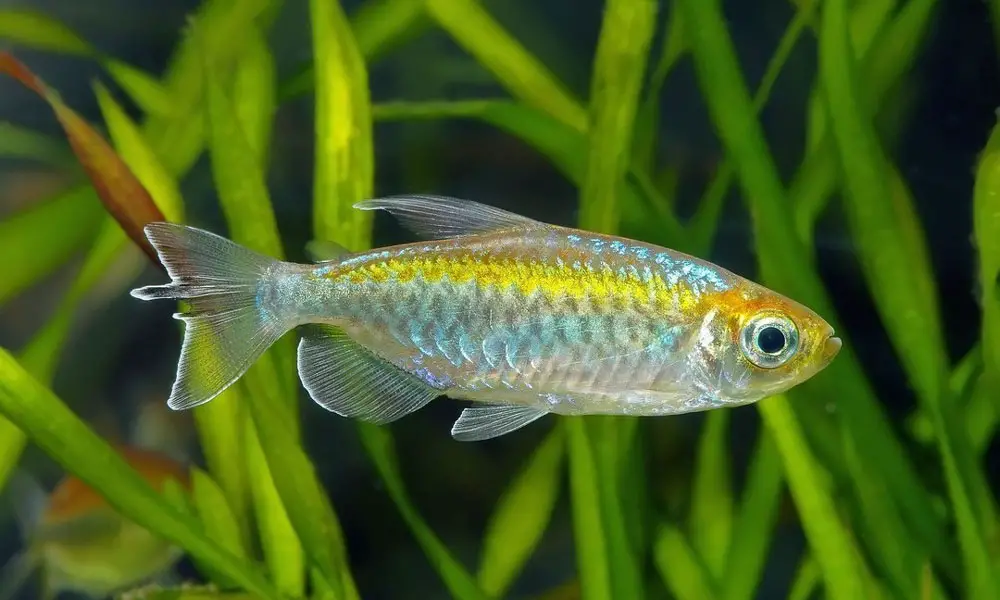
Any list of favored tetra species wouldn’t be complete without Congo Tetra. This large tetra hails from the Congo River in Africa, but most of the specimen sales in the trade are commercially bred in the Far East and Eastern Europe.
Males are larger and more colorful than females. They have a distinct rainbow appearance with a red-orange horizontal stripe in the middle, accompanied by shiny blue scales on the top and belly.
As a shoaling fish, we like to keep this 3″ (8cm) tetra in a group of 6 or more of the same species with other rainbowfish to create an eye-catching combination. Since males have long, flowing fins, boisterous or any fin-nipping tank mates should be avoided.
| Scientific Name: | Phenacogrammus interruptus |
| Common Name: | Congo Tetra |
| Care Level: | Moderate |
| Origin: | Africa |
| Social: | Peaceful schooling fish |
| Tank Level: | All levels |
| Temperature: | 73- 82°F (22.8- 27.8°C) |
| PH: | 6.0 – 7.5 |
| Water hardness: | 3 – 18 dKH |
| Diet: | Omnivorous |
| Minimum Tank Size: | 30 gallons |
Black Skirt Tetra (Gymnocorymbus ternetzi) – 2.9″ (7.5 cm)
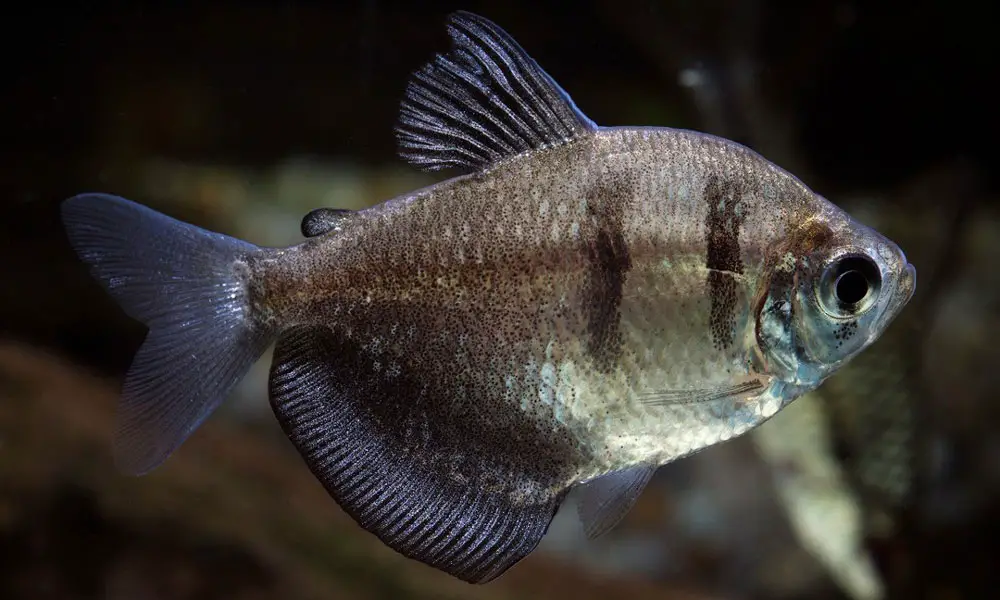
While many tetras have a slender torpedo-shaped body, the black skirt tetra, or black widow tetra, is easily identifiable with its unique tetragonal body shape, prominent dorsal and anal fin, as well as vertical half-black stripes.
In the wild, this beautiful tetra is found in small, slow-moving tributaries and creeks of the Paraguay and Guaporé River basins in Brazil. Because of its popularity in the trade in recent years, a number of different man-made color strains have been produced by captive breeding.
If you’re looking for a unique and striking large tetra to feature in a larger, heavily planted community aquarium, consider a bigger group of 10 or more black skirts.
| Scientific Name: | Gymnocorymbus ternetzi |
| Common Name: | Black Skirt Tetra, black widow tetra |
| Care Level: | Easy |
| Origin: | South America |
| Social: | Peaceful schooling fish |
| Tank Level: | Mid dweller |
| Temperature: | 68- 79°F (20- 26°C) |
| PH: | 5.8 – 8.5 |
| Water hardness: | 0 – 15 dKH |
| Diet: | Omnivorous |
| Minimum Tank Size: | 20 gallons |
Bucktooth Tetra (Exodon paradoxus) – 2.9″ (7.5 cm)
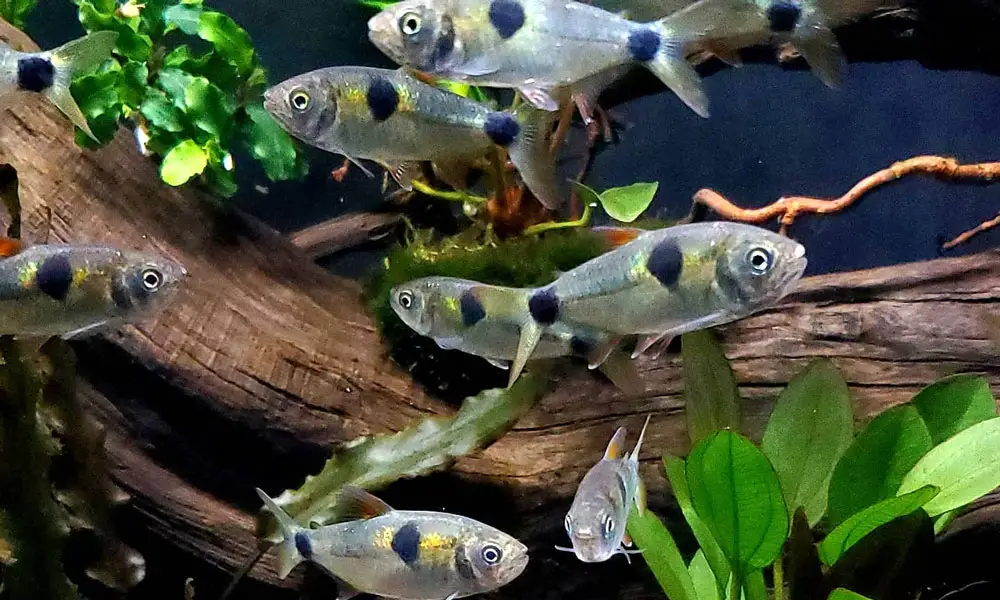
Not all tetras are peaceful community fish. The bucktooth tetra is a predator in nature, which is one of the most aggressive fish available in the freshwater aquarium hobby.
This medium-sized predatory tetra is naturally found throughout Amazon and Tocantins River basins in Brazil. In nature, it primarily feeds on small invertebrates, insects, small fish, shrimp, fish fry, and plants. Additionally, this fish is notorious for scale-eating feeding behavior (lepidophagy).
We would only advise keeping a group of these fish in its own aquarium. No suitable fish can be kept with a scale eater, even these most aggressive CA or SA cichlids.
| Scientific Name: | Exodon paradoxus |
| Common Name: | Bucktooth Tetra |
| Care Level: | Expert |
| Origin: | South America |
| Social: | Predatory fish, scale eater, not for the community |
| Temperature: | 73- 82°F (23- 28°C) |
| PH: | 5.5 – 7.5 |
| Water hardness: | 0 – 20 dKH |
| Diet: | Carnivorous |
| Minimum Tank Size: | 55 gallons |
Redeye Tetra (Moenkhausia sanctaefilomenae) – 2.8″ (7cm)
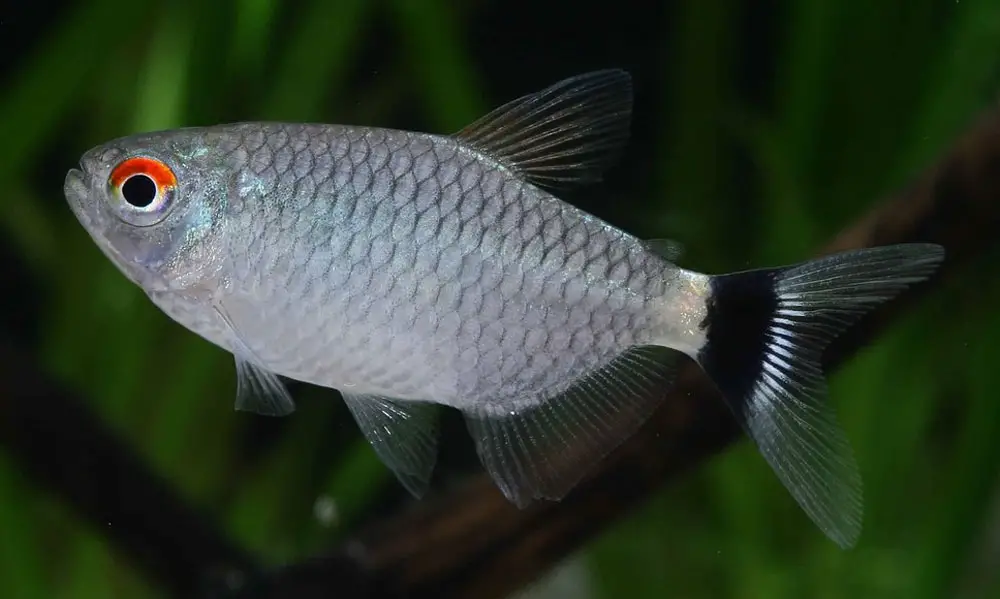
This 2.8-inch (7 cm) large tetra boasts an amazing array of scales and colors when swimming in large groups against a lush green background. The body is bright silver in color with a large red eye and a black tail, giving it the common name “redeye tetra.”
They inhabit clear rivers, flooded forests, and murky areas with thick vegetation in parts of the Amazon. Like other popular species, this freshwater tetra is bred in large numbers commercially in Asia, which is why it’s widely available in pet stores.
This peaceful tetra needs to be kept in a group of 6 or more individuals and makes an excellent addition to any large community aquarium. Since they are relatively large by tetra standards, ensure you have plenty of space for them to swim freely.
| Scientific Name: | Moenkhausia sanctaefilomenae |
| Common Name: | Yellow-banded moenkhausia, yellowback moenkhausia, yellowhead tetra, lamp eye tetra |
| Care Level: | Easy |
| Origin: | South America |
| Social: | Peaceful |
| Tank Level: | Mid-dweller |
| Temperature: | 73- 82°F (23- 28°C) |
| PH: | 5.5 – 8.5 |
| Water hardness: | 0 – 25 dKH |
| Diet: | Omnivore |
| Minimum Tank Size: | 20 gallons |
Diamond Tetra (Moenkhausia pittieri) – 2.4″ (6cm)
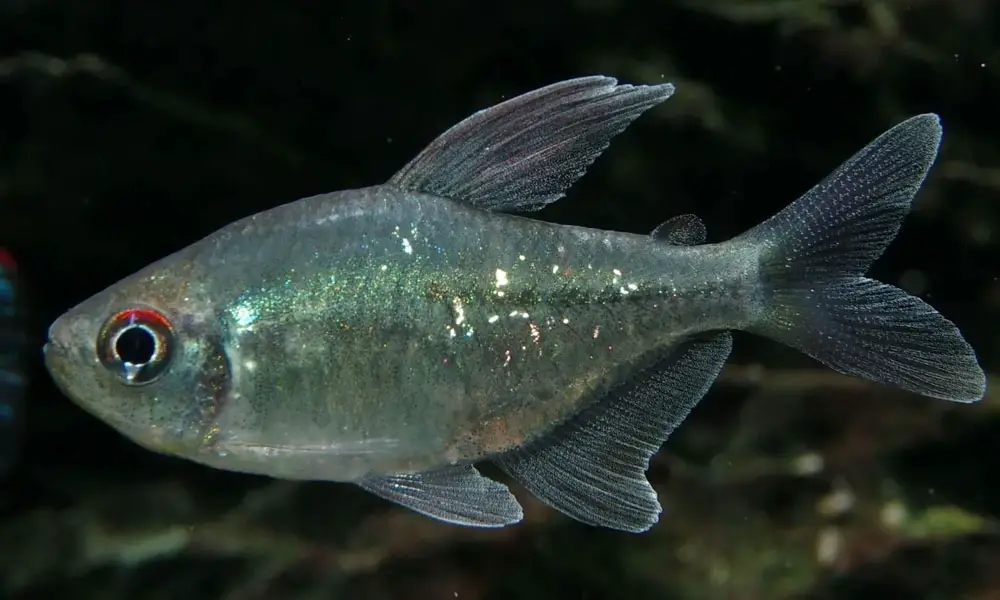
Smaller than its cousins, the glass tetra and red eye tetra, the diamond tetra gets its name from its silvery-violet scales that shimmer and sparkle in the light, just like a diamond.
When found in its native habitats in Lake Valencia, the 2nd largest freshwater lake in Venezuela, diamond tetra has clear sexual dimorphism. Males are typically larger and more brilliantly colored than females. They also develop long, pointed dorsal and anal fins with a purple hue.
This peaceful tetra goes well with other similar-sized community fish, like tetras, small corydoras, livebearers, and barbs. A school of diamond tetras is also quite suitable for many cichlid tanks.
| Scientific Name: | Moenkhausia pittieri |
| Common Name: | Diamond Tetra |
| Care Level: | Easy |
| Origin: | South America |
| Social: | Peaceful |
| Tank Level: | Mid-dweller |
| Temperature: | 73- 82°F (23- 28°C) |
| PH: | 5.5 – 7.5 |
| Water hardness: | 4 – 8 dKH |
| Diet: | Omnivore |
| Minimum Tank Size: | 15 gallons |
Which Ones Are You Interested In?
Tetras are well-loved for their peaceful nature and schooling behavior, except for bucktooth tetra, of course. We hope you have found large tetra that catches your eye!
Your local pet store might not have the fish you’re looking for, but try checking online retailers. They might be able to ship your favorite fish right to your doorstep!
Best of luck with setting up your community aquarium!
Article Sources:
- Brycon amazonicus Colombia [aquariumglaser.de]
- Brycon – an overview [ScienceDirect]
- Data Sources: Fishbase.se
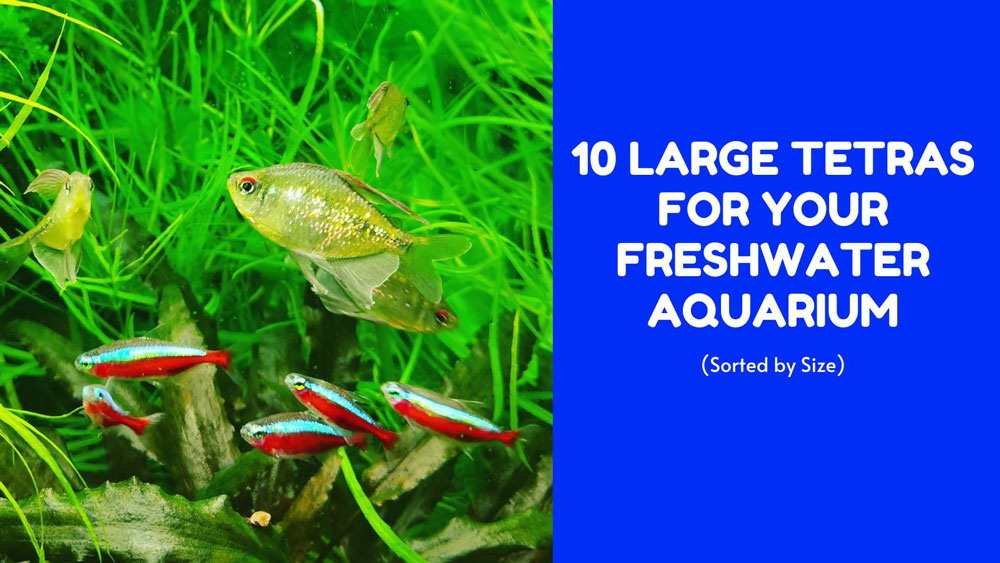





4 thoughts on “10 Large Tetras for Your Freshwater Aquarium with Pictures (2.8″ ~ 6.5″)”
Very helpful, didn’t really know alot on tetras especially wen it came to sizes. Great to know that some of them grow to well over 2 inches. Now i’l keep me eye out for them wen I shop for fish for my freshly set up 8x2x2 ft tank.
Hi
Thanks for reading and glad the information was helpful.
Remember to also research the specific care requirements for the tetra species you’re interested in, as well as compatibility with other fish you plan to keep in your tank.
Good luck with your new setup!
Jeff
Very informative! And I like that there are some African tetras; don’t really here about them too often. However I do have one thing to note, if you don’t mind me saying.
Contrary to popular belief, ten gallons is NOT suitable for black skirts. I don’t mean to sound like one of “those” people, but black skirts one of my absolute favorite fish, and it’s a pet peeve of mine to see so many people recommend such small tanks for an active mid-sized shoaling fish like them, especially when they list more appropriately-sized tanks for other species that around the same size as them, with black skirts always getting singled out like that. In my humble opinion, and based on what I’ve heard, a 30 gallon tank or larger would be best for any shoaling fish that gets up to around 3 inches, including black skirts. I don’t know why people keep saying that a 10 or 15 gallon is fine for these big guys.
Hope you don’t mind my rant, I don’t mean to be rude or anything, but it’s just something I’m very passionate about.
I also want to note that I really like that you made this list; most people only ever talk about the smaller tetras so it’s nice to see the bigger ones getting some attention!
Hi Gar,
Thank you for taking the time to leave a comment. I’m glad to hear that you found the post informative and enjoyed learning about some African tetras that are not often talked about.
I appreciate your feedback and your passion for the well-being of fish. Thank you for bringing to my attention the issue with recommending a 10-gallon tank for black skirts. You’re right that they are an active mid-sized shoaling fish and need appropriate space to thrive. I will definitely take your advice into consideration and update my post accordingly.
Thank you again for sharing your knowledge on the topic. I look forward to hearing from you again in the future.
Best,
Jeff